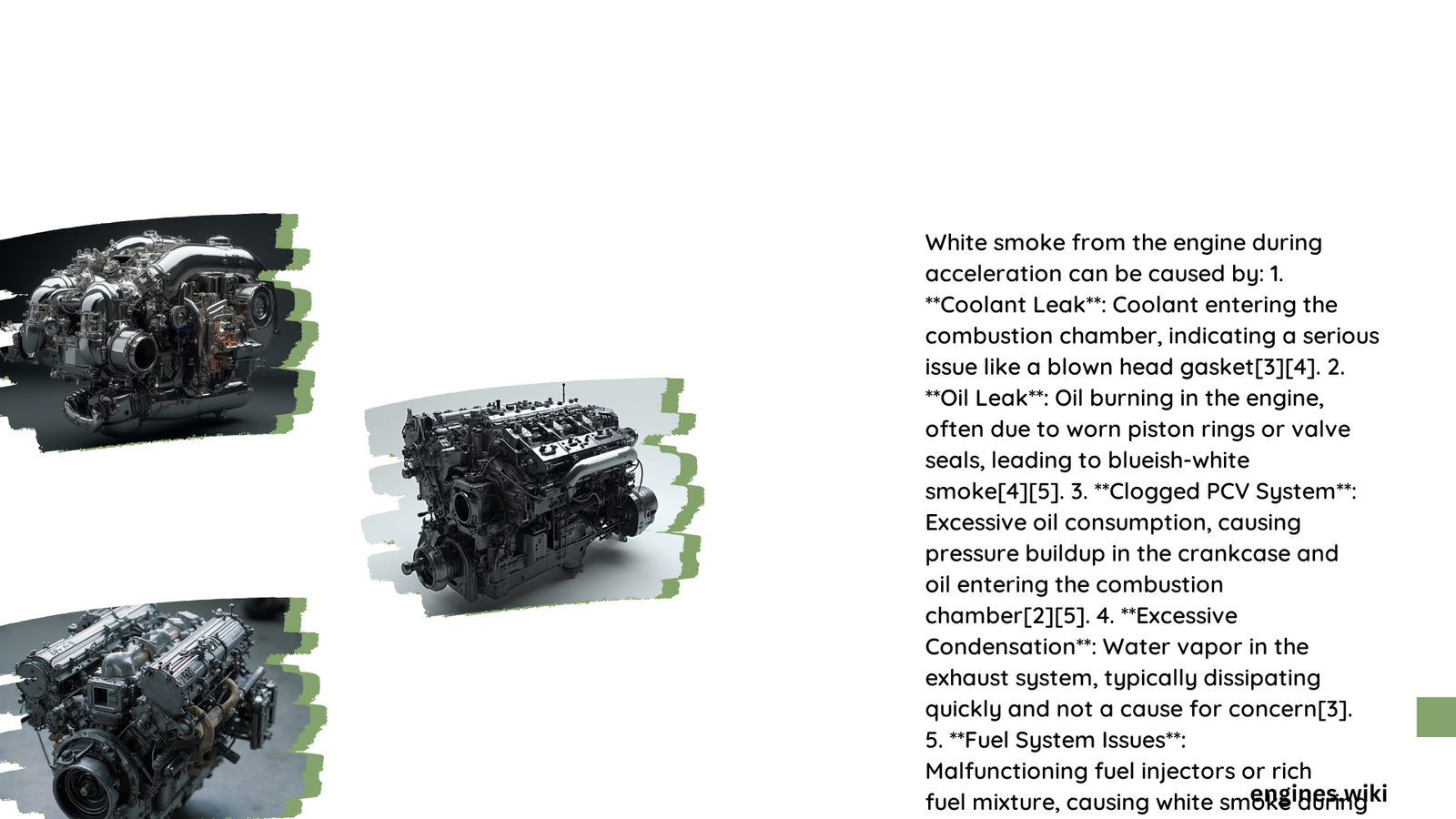White smoke from the engine when accelerating is a concerning symptom that can indicate various underlying issues. This problem often stems from coolant or oil entering the combustion chamber, or fuel system malfunctions. The severity can range from minor to major, potentially leading to significant engine damage if left unaddressed. Understanding the causes, diagnostic methods, and potential fixes is crucial for maintaining your vehicle’s health and performance.
What Are the Common Causes of White Smoke from Engine When Accelerating?
Several factors can contribute to white smoke emission during acceleration:
- Head Gasket Leak: This allows coolant to mix with combustion gases.
- Oil Leak or Consumption: Oil enters the combustion chamber due to worn components.
- Fuel System Issues: Malfunctioning injectors or rich fuel mixture.
- Turbocharger Problems: Oil leaks through damaged turbo seals.
- Coolant Leak: Coolant enters the combustion chamber through various pathways.
Let’s delve deeper into each of these causes:
How Does a Head Gasket Leak Cause White Smoke?
A head gasket leak is a serious issue that can lead to white smoke emission. Here’s what happens:
- Coolant mixes with combustion gases
- White smoke with a sweet smell is produced
- Engine may overheat
- Oil dipstick might show a milky substance
Key Symptoms:
– Sweet-smelling white smoke
– Engine overheating
– Milky oil
– Possible coolant level drop
Why Does Oil Leak or Consumption Result in White Smoke?
Oil entering the combustion chamber can cause white or bluish smoke, especially during acceleration. This can occur due to:
- Worn piston rings or cylinder walls
- Malfunctioning Positive Crankcase Ventilation (PCV) system
- Failing scavenger pump in some engine designs
Identifiable Signs:
– White or bluish smoke with an oil smell
– Possible ticking or tappet noise after acceleration
– Increased oil consumption
How Do Fuel System Issues Contribute to White Smoke?
Fuel system problems can lead to white smoke emission:
- Malfunctioning fuel injectors may cause incomplete combustion
- Rich fuel mixture can result in unburned fuel being expelled as white smoke
Notable Symptoms:
– White smoke without a distinct smell
– Poor engine performance
– Potential check engine light illumination
What Role Do Turbocharger Issues Play in White Smoke Production?
While not as common, turbocharger problems can cause white smoke:
- Oil can leak through damaged turbocharger seals
- This oil enters the combustion chamber and burns, producing smoke
Telltale Signs:
– White or bluish smoke
– Loss of turbocharger boost
– Increased oil consumption
How Can a Coolant Leak Lead to White Smoke?
Coolant entering the combustion chamber will produce white smoke:
- Often accompanied by a sweet smell
- May not cause overheating if the leak is small
- Can be due to various issues, including cracked cylinder head or block
Key Indicators:
– Sweet-smelling white smoke
– Dropping coolant levels
– Possible absence of overheating with small leaks
What Are the Diagnostic Steps and Tools for White Smoke Issues?

Proper diagnosis is crucial for addressing white smoke problems effectively. Here are some key diagnostic approaches:
How to Check Oil Consumption Rate?
- Regularly monitor oil levels
- Conduct oil consumption tests:
- Measure oil level over a set distance or time
- Calculate consumption rate
What Methods Are Used to Check Coolant Levels?
- Visually inspect coolant reservoir
- Look for visible leaks in the cooling system
- Use a coolant test kit to check for system leaks
How Is Exhaust Gas Analysis Performed?
- Utilize an exhaust gas analyzer
- Check for presence of coolant or oil in exhaust gases
- Look for high levels of hydrocarbons (HC) or carbon monoxide (CO)
What Does a PCV System Check Involve?
- Inspect PCV system for blockages
- Perform a vacuum test to check proper operation
What Should Be Included in a Visual Inspection?
- Check for visible oil leaks around:
- Valve cover gasket
- Piston rings
- Turbocharger seals
- Inspect exhaust system for blockages or damage
What Are the Acceptable Oil Consumption Specifications?
Understanding normal oil consumption is crucial for diagnosing issues:
| Engine Type | Acceptable Consumption |
|---|---|
| Most engines | 1 quart per 1,000-1,500 miles |
| High-performance | May vary, consult manufacturer |
Note: Consumption above these rates is considered excessive and warrants investigation.
How Do Different Oil Grades Impact Consumption?
- Using the correct viscosity and type as specified by the manufacturer is crucial
- Incorrect grades can lead to increased consumption and wear
- High-performance oils may reduce consumption in some cases
What Are the Estimated Costs and Timeframes for Repairs?
Repair costs and durations can vary widely based on the underlying issue:
Head Gasket Replacement
- Cost Range: $1,000 – $2,500
- Labor Time: 5-10 hours
Turbocharger Repair or Replacement
- Cost Range: $1,500 – $5,000
- Labor Time: 10-20 hours
PCV System Repair
- Cost Range: $150 – $700
- Labor Time: 1-3 hours
Oil Leak Repair
- Cost Range: $300 – $1,500
- Labor Time: 2-5 hours
Note: These are estimates and can vary based on vehicle make, model, and location.
How Can White Smoke Issues Be Prevented?
Preventive measures can help avoid white smoke problems:
- Regular oil changes with the correct grade
- Timely coolant system maintenance
- Addressing minor leaks promptly
- Following manufacturer-recommended service intervals
- Avoiding prolonged idling or excessive short trips
By understanding the causes, diagnostic methods, and potential fixes for white smoke from the engine when accelerating, you can better maintain your vehicle and address issues promptly. Remember, early intervention can often prevent more serious and costly repairs down the road.
References:
1. Rennlist Forum: Smoking under hard acceleration then ticking noise from engine
2. Subaru Forester Forum: 2015 – White smoke from tailpipe after hard acceleration
3. WhipFlip Blog: White Smoke from The Exhaust: Causes & How to Fix It
